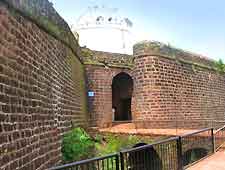Goa History Facts and Timeline
(Goa, Goa, India)

The smallest state in India, Goa, lies along the Arabian Sea coastline and is famed for its glorious beaches, laid-back lifestyle and iconic charm.
Once a Portuguese Catholic colony, it has three main towns - the state capital of Panaji (Panjim), Margao and Vasco da Gama, all of which exhibit many fascinating remnants of the history of picturesque Goa.
Early Beginnings
Ancient Hindu scriptures note Goa as the temporary home of Lord Shiva and the site of a legendary battle between Lord Krishna and King Jarasandha. Settlement of the region occurred some 10,000 years ago, as confirmed by Palaeolithic rock art and stone tools from across the state, which are now displayed in local museums. Buddhism arrived in the 3rd century and the region passed between various city-state rulers, until the Portuguese arrived in 1510.
Portuguese Colonisation
After defeating the Goan rulers, the Portuguese established a foothold in Old Goa, (Velha Goa) and continued to expand their domination over the region. By 1843, most of the state was under their control, and the capital was moved to Panaji in the same year.
Catholicism took hold, although among the indigenous population it was underpinned by continuing Hindu beliefs, a mix which continues to the present day. A vital trade route from its earliest history, Goa continued as a hub for the shipping of spices, pearls and other treasures to
Portugal and the West.
In the 50 years from 1575 to 1625, Goa reached its zenith as regards prosperity. During this time, most of the state's historic buildings were constructed and its towns became famous for their beauty. Missionaries arrived, as did the Inquisition, with its self-enriching activities now widely derided by the Catholic Church. Dutch ships began harassing the ports, marking the beginning of the decline of Portuguese rule in the region, and by 1635, all foreign religious representatives in the state were banned.
Revolt and Republic
Beginning in the mid-19th century, the people of Goa rebelled against Portuguese rule on 14 separate occasions, culminating in the 1910 declaration of the state as a republic. This was a short-lived development, as Portugal suppressed all the rebellions until 1961, 14 years after India's independence from British rule. Even then, liberating military action named 'Operation Vijay' was forced, as Indian Prime Minister Nehru was unable to persuade Portugal to give up its colony voluntarily. Public vote finally saw the newly autonomous territory of Goa become an Indian state in 1987.
The Present Day
Nowadays, Goa is world-famous as a tourism destination as much for its fascinating history and picturesque towns, villages and cities, as for its golden beaches and stunning scenery.
The state's many museums display heritage artefacts from all periods and religions, and its ancient temples, convents and churches are best seen within Old Goa, which serves as the meeting point of cultures and is now a UNESCO World Heritage site.
 The smallest state in India, Goa, lies along the Arabian Sea coastline and is famed for its glorious beaches, laid-back lifestyle and iconic charm.
The smallest state in India, Goa, lies along the Arabian Sea coastline and is famed for its glorious beaches, laid-back lifestyle and iconic charm.